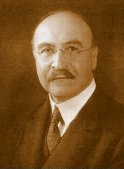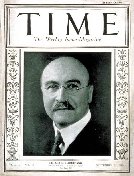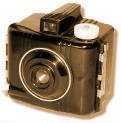|
|
Bakelite - The Material of a Thousend Uses
The Career of the First Real Plastic
In 1907 an epoch-making discovery was in the wind - as often in the history of science and technique - this time concerning the development of plastics, whose history went back more than four decades in those days.(Parkesine 1862, Celluloid 1868, Galalith 1897 ![]() dictionary).
dictionary).
|
In the beginning of the 20th century by no means was settled who would win fame for the invention of a heat- and solvent-resistant phenole-formaldehyde-plastic, which moreover was outstandingly suitable for electric insulation and industrial use. Because on one hand scientists had carried out chemical experiments with mixtures of phenole or other substances with formaldehyde and published their results for thirty years, even if they didn´t recognize the technical advantage of their substances or were not able to make good use of them. On the other hand many chemists made an effort to find the growing electrical industries a more cost-effective insulation material than the scarce and therefore expencive shellac was - an extravagant natural product made of the resinous secretion of an east-indian louse species. So it was just a question of time until the idea was born to associate the phenolic resin experiments with the demands of the electrical industries. Indeed - several tinkerers got on to the problem but only one is known as the inventor of Bakelite, that is Leo Hendrik BAEKELAND, a Flame, emigrated to the USA, who in 1907 applied for the famous "Heat and Pressure Patent" and completely immodestly named his plastic after himself. The substance, originally intended as a shellac substitute, turned out to be an astonnishing multi-purpose talent. It was superior to other substances in many regards and employable in varied fields so that BAEKELAND hit on the marketing slogan "The Material of a Thousand Uses". Already in the twenties the first entire sythetic plastic was indispensable in most industry branches. - The plastic aera had begun. Chronology
1872 Adolf von BAEYER (famous for his syntheses of indigo, Nobel prize 1905
1891 The German Chemist Werner KLEEBERG, a student of BAEYER, experimented with BAEYER´s phenol-formaldehyde reaction using hydrochloric acid as a catalyst. The result was a substance similar to BAEYER´s goo - but it was insoluble, infusible and chemical inert. KLEEBERG didn´t follow this project, blind for it´s chances, because he was searching for a material that was able to crystallize. 1899 Arthur SMITH got a British patent for a solid phenol-formaldehyde product that developed from a reaction with the solvents methyle- and amyle-alcohol. It needed several days for hardening with 100 C and deformed during this process - bad conditions for a success story. 1902 Intending to get a shellac substitute Carl Heinrich MEYER, a Chemist from the German town Zwickau, condensed the first synthetic resin of the world - from phenol and formaldehyde adding an acid. In the same year a patent was applyed - by MEYERS employee, the businessman Louis BLUMER who produced the stuff in his Zwickau chemical plant and marketed it as "Laccain". Dissolved in other agents the fusible resin was used as lacquer and glue. Later BAEKELAND called this kind of resins "Novolac". 1902 The Austrian Chemist Adolf LUFT who in opposite to KLEEBERG had a feeling for the commercial potentials of his substance, likewise mixed phenol and formaldehyde - however aiming at creating a celluloid-like hard-plastic. But the amber-like material which he got by adding camphor was to brittle for technical use. 1905 Henry STORY did without solvent and catalyst and made a phenol-formaldehyde mixture in the relation of 2:1 which he cooked 8 to 10 hours before hardening with 80 C. It´s true the result was an insoluble and infusible material but the hardening process was irregular and not complete. 1904/1907 The British electrical engeneer James SWINBURNE was not discouraged by all those flops, for he recognized the potential of phenol resins as a heat-resistant electrical insulator and had been searching for a chance to improve KLEEBERG´s "frozen beer" (SWINBURNE) since 1904. In caustic soda he eventually found a suitable solvent and wanted to apply his process for a patent. During the presentation in the British patent office he was shocked by the information, that he was anticipated by an american competitor just the day before - Leo BAEKELAND.
1902/1907 Also BAEKELAND - mindfull of the lack of a more costeffective alternative to shellac - had studied the works of BAEYER, KLEEBERG and his other ancestors and since 1902 had begun to vary their fierce phenole-formaldehyde reactions. Adding caustic soda (NaOH) or another base he got a solid body that was resistent to heat and solvents. The problem of the fierce gas extrication he first tried to cope with a deceleration of the reaction with low temperatures until he hit upon the rescuing idea to increase the temperature and to controle the gas extrication by pressure. In his garage in Yonkers, New York, he therefore developped the "Bakelizer", a steam heated airsealed kettle in which pressure and temperature could exactly be adjusted. A further essential aspect of BAEKELAND´s work was the superdivision of the reaction into three steps. So he could control the chemical processes completely and furnished the industry with a ready and complete manufacturing method.
1907, 14th of July BAEKELAND applied for his "Heat and Pressure Patent"(AP 942699, in Germany 1908: DRP 233803), which was followed by others with the subject phenole-formaldehyde resins in short intervalls. 1909, 5th of February In the "Chemist´s Club" of New York he introduced his invention to the world public. He impressed the journalists present with little tricks, like for instance the impregnation of wood sticks, a child´s play because the wood constituent lignine chemicaly resembles the phenol. 1910 Being the first company in the world the Bakelite GmbH began on the industrial production of phenole resins; and that in a little nest named Erkner just before the town gates of Berlin. A few months before BAEKELAND had founded the still existing company (now Bakelite AG) together with the Rütgers company (May 25). In those days the Rütgers works preserved railway sleepers with tar oil on a large scale. With its production an amount of the sometimes badly marketable by-product phenol was left over. But with BAEKELAND´s new process of phenole resin production it was possible to profit from the undesirable stuff considerably - as at once had been recognized by the Rütgers managers. By the way: The commutity of Erkner is still suffering from the legacy of the Rütgers company and the GDR-successor. Soil and groundwater are extensivly contaminated with phenole and other toxic chemicals. 1910 BAEKELAND founded the General Bakelite Company in Perth Amboy, New Jersey (October 10), after his garage had burned off. He successfully exerted himself for licensees and partnerships in foreign countries. 1911 The General Bakelite Company took up production of phenole resins. 1914/18, World War I The defence-industry benefited from the positive properties of Bakelite in the production of ignition facilities, shell cases and aeroplane propellers. When phenole run short because of its employment for explosives cresilic acid and cresole were used for the Bakelite production 1920 It was estimated in those days that 43 industry branches directly profited from Bakelite. 1922 Bakelite was highly appreciated, also by plagiarists. BAEKELAND payed high attention on the observence of his patent rights and hauled everybody before the judge, who in his oppinion had offended against them. Also Sir SWINBURNE, who had distributed his phenole plastic under the name "Damard" (realy: damn hard) regardless of the BAEKELAND patents, was not spared. The result of BAEKELANDS efforts was the merging of Damard Laqueurs, other sued companies (Redmanol Co., Condensite Co.) and BAEKELAND´s own General Bakelite Co. into a new enterprise, the Bakelite Corporation. 1924, 22nd of September The TIME-Magazine was published with a picture of BAEKELAND on the front page. Beneath was written: "It will not burn. It will not melt." An excerpt from the article: "Specifically, it is a composition, born of fire and mystery, having the rigor and brilliance of glass, and luster of amber from the Isles. Poetically, it is a resin formed from equal parts of phenol and formaldehyde, in the presence of a base, by the application of heat. It will not burn. It will not melt. It is used in pipe stems, fountain pens, billiard balls, telephone fixtures, castanets, radiator caps, etc. In liquid form it is a varnish. Jellied, it is glue. Those familiar with its possibilities claim that in a few years it will be embodied in every mechanical facility of modern civilization. From the time that a man brushes his teeth in the morning with a bakelite handled toothbrush, until the moment he falls back upon his bakelite bed (in the evening), all that he touches, sees, uses, will be made of this material of a thousand uses." Since middle of the 20s In the USA famous industry designers took care of the bakelite (Paul FRANKL, Raymond LOEWY, Norman BEL GEDDES, Henry DREYFUSS, Walter Dorwin TEAGUE a.o.) and there made it epitome of Art Déco with swinging - not allways functional - streamline forms. In Europe however the famous Bauhaus designers prefered classical and precious materials like wood, leather, metal and glass. The Bakelite remained a cost-effective and functional material without any flair. 1924 With growing production the offered product range of press masses - different phenole resins with a multitude of additives - was more and more confusing for the processing companies. That´s why in Germany the resin producing and the resin processing companies founded a technical union (T.V. der Hersteller typisierter Pressmassen und Pressstoffe)for the supervision of quality standards, which were compiled by the Union of German Electrical Engineers (VDE), the Department of Material Testing (Materialprüfungsamt) and the Physical-Technical State Institute (Physikalisch-Technische Reichsanstalt). 1927 BAEKELAND´s patents concerning the manufacturing process of Bakelite expired and as of the appearence of other producers the production of phenole resins increased enormously. For that reason BAEKELAND had promoting his product intensively. Attracting considerable attention the Parker company flung its "Duofold" Bakelite pencil case from the 23rd floor on the 5th Avenue where it was picked up - of course unbroken. End of 20s BAEKELAND declared he couldn´t name 43 industry branches that did not use Bakelite. 1934 In Germany besides the Bakelite AG six further companies produced press masses made of phenole resins, which were processed by about 600 companies. Bakelite was distributed under many different trade marks. 1936 FORTUNE crowned the Bakelite king of plastics and wrote: "Your fountain pen, your light switch, your lampshades and spectacle frames, electrical insulators of all kind and your telephone receiver - everything is almost entirely consisting of bakelite plastic".
End of 30s Bakelite increasingly entered into competition with other plastics like Catalin, Melamin, Plaskon, Nylon a.o. 1939 BAEKELAND sold his Bakelite Corp. to Union Carbide and retired from business. 1939/45 Bakelite was obliged to war service again and is said to have contributed to the development of the atomic bomb - so at least reports Stephane GROUFF, who wrote about the Manhattan-Project as one of the first authors.
1950 until today In everyday life the glamour of Bakelite faded rapidly beneath the screaming colours of other plastics - at least in the US. In Europe it succeeded until the early sixties - in grey Eastern Europe, behind the iron curtain, even longer. But furthermore Bakelite and its relatives took effect secretly and still are doing today: as insulators, switch parts, sockets, wrapings and bounding agents. Even the heat sheeld (
Bakelite in literature Yes indeed! Here an example from "The Astronauts (Astronauci)" written in 1951 by the Polish author Stanislav LEM (his famous novel "Solaris" was twice adapted for the screen: by Andrei Tarkovsky 1972 and by Steven Soderbergh 2002). Do you know any other examples of Bakelite in literature? If yes, please mail! |
|

 Bakelizer
Bakelizer Bakelite mould
Bakelite mould Advertisement for
Advertisement for  Advertisement for a
Advertisement for a Bakelite advertisement
Bakelite advertisement Bakelite catalogue
Bakelite catalogue The trade marks of
The trade marks of Time cover
Time cover
 Copy machine
Copy machine  "Baby Browny" by
"Baby Browny" by Bakelite advertisement
Bakelite advertisement Advertisement for
Advertisement for Advertisement for
Advertisement for The Jupiter probe
The Jupiter probe